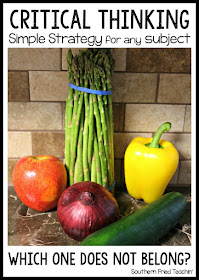Critical thinking is a big buzz word these days. With the standardized testing getting more challenging every year, incorporating critical thinking into our everyday curriculum and teaching has become a necessity.
OK. I agree, you say. Sounds good, you say.
But just HOW do you do that?
I've got an answer for you.
And it's simple.
And you can use this strategy for any subject.
And you can start using it tomorrow.
Raise your hand if you watched Sesame Street growing up.
Yes, I am totally raising my hand. I LOVED Sesame Street.
There was a song/game that they played on Sesame Street. It's one of those songs that gets in your head and won't go away. Don't you just love those songs?
This song/game is called "One of these things is not like the others". Simple concept, right?
I started using this strategy in my classroom several years ago, and wow....it made a huge difference. And it forced my students to think. Really think.
Let me show you some examples of how I use it in my classroom.
In 5th grade math with prime numbers - 28 does not belong because it's the only composite number
In 6th grade world cultures with forms of government
I would use them as warm-up questions, and I would make my students explain why their answer did not belong.
I have also created some task cards using the same cards. This really did help my students better understand their math facts.
This concept works with any topic and any subject. Here's something I created to help my students with finding the sums.
This concept is so easy to implement! Try it in your classroom...I'd love to hear how it goes!
Visit Southern Fried Teachin''s profile on Pinterest.
OK. I agree, you say. Sounds good, you say.
But just HOW do you do that?
I've got an answer for you.
And it's simple.
And you can use this strategy for any subject.
And you can start using it tomorrow.
Raise your hand if you watched Sesame Street growing up.
Yes, I am totally raising my hand. I LOVED Sesame Street.
There was a song/game that they played on Sesame Street. It's one of those songs that gets in your head and won't go away. Don't you just love those songs?
This song/game is called "One of these things is not like the others". Simple concept, right?
I started using this strategy in my classroom several years ago, and wow....it made a huge difference. And it forced my students to think. Really think.
Let me show you some examples of how I use it in my classroom.
In 5th grade math with prime numbers - 28 does not belong because it's the only composite number
In 6th grade world cultures with forms of government
I would use them as warm-up questions, and I would make my students explain why their answer did not belong.
I have also created some task cards using the same cards. This really did help my students better understand their math facts.
This concept works with any topic and any subject. Here's something I created to help my students with finding the sums.
This concept is so easy to implement! Try it in your classroom...I'd love to hear how it goes!







Great strategy, Angela. I think I'll start using that with my first graders.
ReplyDeleteI think that's a great idea! Please come back and share how it went!
DeleteAngela
What are these called in your store? I would love to use them for my 3rd graders!
ReplyDeleteThey are called Which Ones Do Not Belong. I have category of them in my store. Here are the links to the ones included in this post. There are others there as well.
DeleteWhich Does Not Belong - multiplication facts
Which Does Not Belong - mixed facts
Which Does Not Belong - sum to the thousands
Hope you and your students enjoy them!
Angela
I've been using these for over 20 years, when I learned about them in grad school. However, the ones I design are open ended, so that it encourages critical thinking. For example, I'll use 0, 1, 2 and 3, and students will point out things like "0 is the closest number to the negatives," or "1 does not belong because it does not have any curves when you write it," or "2 does not belong because it's the only non-zero even number." The point is to encouraged creative thinking, not make it a "right" or "wrong' answer.
ReplyDeleteYes! The critical thinking comes from being able to choose and justify any of the options!
DeleteI plan on using them to see how many different options are there - for instance, the first panel you post one is even, the rest odd. Another is the tens digits are different as well as prime vs. composite.
ReplyDeleteI LOVE these, especially ones where there's more than one answer. I also challenge my students to come up with their own and require that three of the four numbers are able to be the one that doesn't belong - that's a real challenge! We take everything in to account, multiples, symmetry, parallel lines, odd/even….
ReplyDeleteThis is i an interesting strategy. It can be develop. Maybe easy to hard differences can add on it.
ReplyDelete